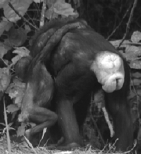Sex at Dawn: The Prehistoric Origins of Modern Sexuality (38 page)
Read Sex at Dawn: The Prehistoric Origins of Modern Sexuality Online
Authors: Christopher Ryan,Cacilda Jethá
Tags: #Non-Fiction, #Sociology, #Psychology, #Science, #Social Science; Science; Psychology & Psychiatry, #History

The visual similarity between these two bits of female anatomy has been facilitated by the recent popularity of low-cut jeans that teasingly reveal the nether cleavage. “The butt crack is the new cleavage,” writes journalist Janelle Brown, “reclaimed to peek seductively from the pants of supermodels and commoners alike…. It’s naughty and

slightly tawdry,” she continues, “but with the soft round charm of a perfect pair of breasts.”14 If your moon is waning, you can always don a “butt bra” from Bubbles Bodywear, which promises to create the effect that’s been turning male heads since before men existed. Like the Victorian bustle, the butt bra mimics the full curves of the ovulating chimp or bonobo. Speaking of waning moons, it’s worth noting that unless her breasts are artificially enhanced, as a woman’s fertility fades with age, so do her breasts—further supporting the claim that they evolved to signal fertility.
Female bonobo. Photo: www.friendsofbonobos.org

Victorian bustle. Photo: Strawbridge & Clothier’s Quarterly (Winter 1885–86)
Human females aren’t the only primates with fertility signals on their chests. The Gelada baboon is another vertically oriented primate with sexual swellings on the females’ chests.
As we’d expect, the Gelada’s swellings come and go with the females’ sexual receptivity. As the human female is potentially
always
sexually receptive, her breasts are more or less always swollen, from sexual maturity on.15

The Butt Bra. Photo: Sweet and Vicious LLC Company slogan: “Take Your Gluteus to the Maximus!” But not all female primates have genital swellings that visually announce their ovulatory status. Meredith Small reports that only fifty-four of the seventy-eight species surveyed “experience easily seen morphological changes during cycles,” and that half of these showed “only slight pinkness.” Once again, our two closest primate cousins stand out from the pack in terms of their decidedly indiscreet sexuality, being the only primates with such extravagant, brightly colored sexual swellings. The female chimp’s red-light district comes and goes, reflecting the waxing and waning of her fertility, but as Small confirms, the bonobo’s
“swellings never change much, so that bonobo females always give a signal of fertility—much as humans do.”16
Although many theories claim the human female has “hidden ovulation,” it’s not really hidden at all, if you know how and where to look. Martie Haselton and her colleagues found that men shown photographs of the same thirty women—some taken around ovulation and others not—were quite good at judging when the women were “trying to look more attractive,” which in turn corresponded to the women’s menstrual status. These authors found that women tend to dress more fetchingly when they are more likely to be fertile.
“Moreover,” writes Haselton, “the closer women were to ovulation when photographed in the fertile window, the more frequently their fertile photograph was chosen.”17
Other researchers have found that men preferred women’s bodily smells near ovulation and that women tend to behave more provocatively in various ways when they’re likely to be fertile (they wear more jewelry and perfume, go out more, are more likely to hook up for casual sexual encounters, and are less likely to use condoms with new lovers).
Come Again?
Much as women’s breasts have fascinated evolution-minded theorists, the female orgasm has confounded them. Like breasts, female orgasm is a major head-scratcher for mainstream narratives of human sexual evolution. It’s not necessary for conception, so why should it exist at all? For a long time, scientists claimed that women were the only female animals to experience orgasm. But once female biologists and primatologists arrived on the scene, it became obvious that
many
female primates were having orgasms.
The underlying motivation for claiming that female orgasm was unique to human beings probably lay in the role it played in the standard narrative. According to this view, orgasm evolved in the human female to facilitate and sustain the long-term pair bond at the heart of the nuclear family.18 Once you’ve swallowed that story, it becomes problematic to admit that the females of other primate species are orgasmic, too.
Your problem gets worse if the most orgasmic species happen to be the most promiscuous as well, which appeares to be the case.
As Alan Dixson writes, this monogamy-maintenance explanation for female orgasm “seems farfetched. After all,” he writes, “females of other primate species, and particularly those with multimale–multifemale [promiscuous] mating systems such as macaques and chimpanzees, exhibit orgasmic responses in the absence of such bonding or the formation of stable family units.” On the other hand, Dixson goes on to note, “Gibbons, which are primarily monogamous, do not exhibit obvious signs of female orgasm.”19 Although Dixson

classifies humans as mildly polygynous in his survey of primate sexuality, he seems to have doubts, as when he writes, “One might argue that … the female’s orgasm is rewarding, increases her willingness to copulate with a variety of males rather than one partner, and thus promotes sperm competition.”20
Donald Symons and others have argued that “orgasm is most parsimoniously interpreted as a potential all female mammals possess.” What helps realize this “potential” in some human societies, argues Symons, are “techniques of foreplay and intercourse
[that]
provide
sufficiently
intense
and
uninterrupted stimulation for females to orgasm.”21 In other words, Symons thinks women have more orgasms than mares simply because men are better lovers than stallions. Stomp your foot three times if you believe this.
In support of his theory, Symons cites studies like Kinsey’s showing that fewer than half of women questioned (Americans in the 1950s) experienced orgasm at least nine out of ten times they had intercourse, whereas in other societies (he refers to Mangaia, in the South Pacific), elaborate and extended sexual play result in nearly universal orgasm for women. “Orgasm,” Symons concludes, “never is considered to be a spontaneous and inevitable occurrence for females as it always is for males.” For Symons, Stephen Jay Gould, Elisabeth Lloyd,22 and others,
some
women have orgasms
sometimes
because
all
men do
every time.
For them, the female orgasm is the equivalent of male nipples: a structural echo without function in one sex of a trait vital in the other.
Given all the energy required to get there, it’s surprising that the female reproductive tract is not a particularly welcoming place for sperm cells. Researchers Robin Baker and Mark Bellis found that approximately 35 percent of the sperm are ejected within half an hour of intercourse and those that remain are anything but home free.23 The female’s body perceives sperm as antigens (foreign bodies) that are promptly attacked by anti-sperm leucocytes, which outnumber sperm 100:1. Only one in 14 million ejaculated human sperm even reach the oviduct.24 In addition to the obstacles imposed by the female’s body, even those lucky few sperm are going to run into competition from other males (at least, if our model of human sexuality has any validity).
But while presenting obstacles to most sperm, the woman’s body can assist others. There is striking evidence that the female reproductive system is capable of making subtle judgments based upon the chemical signature of different men’s sperm cells. These assessments may go well beyond general
health
to
the
subtleties
of
immunological
compatibility. The genetic compatibility of different men with a given woman means that sperm quality is a
relative
characteristic.
Thus, as Anne Pusey explains, “Females may benefit from sampling many males, and different females will not necessarily benefit from mating with the same ‘high quality’ male.”25
This is a crucially important point. Not every “high quality” male would be a good match for any specific woman—even on a purely biological level. Because of the complexities of how the two sets of parental DNA interact in fertilization, a man who
appears
to be of superior mate value (square jaw, symmetrical body, good job, firm handshake, Platinum

AMEX card) may in fact be a poor genetic match for a particular woman. So, a woman (and ultimately, her child) may benefit by “sampling many males” and letting her body decide whose sperm fertilizes her. Her body, in other words, might be better informed than her conscious mind.
So, in terms of reproduction, the “fitness” of our prehistoric male ancestors was not decided in the external social world, where conventional theories tell us men competed for mates in struggles for status and material wealth. Rather,
paternity
was determined in the inner world of the female reproductive
tract where every woman is equipped with mechanisms for
choosing among potential fathers at a cellular level.
Remember this next time you read something like, “The predisposition for influence, substance and prestige are all merely expressions of a male positioning himself to acquire women with whom to mate,” or, “Mate competition will involve contests over resources [men’s] wives will need to raise children.”26 This may well be the situation for most people today, but our bodies suggest our ancestors faced an entirely different scenario.